How to sell your SaaS to Enterprise Customers
Table of Contents
This article is part of the series called Founders Guide which I’m writing currently to help early-stage founders tackle the problems they face during the first year of the startup.
The idea of starting a new company sounds exciting — you get a team, put your ideas to test, set the cash register on fire and create a lasting legacy. Everything's fine and dandy, until reality hits — you need to make money to take your startup anywhere beyond the first step. Selling as a startup in the first year is not easy, especially when you're aiming for enterprise customers.
It's difficult enough to build a sales team and strategy when you don't have the money, resources, or market leverage. And a lot of wide-eyed early-stage startups realize this the hard way — your exciting idea means little to the enterprise customers when the number of decision-makers is higher than your entire team. The trick is to think like a hacker. And not losing hope.
I'll share my experience of closing deals with big-ticket clients so that you can avoid the enterprise sales traps. For this, I'll go over
- The elements that make enterprise sales
- How to establish an enterprise sales strategy
- Best practices to follow (and red flags to avoid)
- Branching out to the sales territory as a technical co-founder
Selling to enterprise customers as a startup
Early-stage startups need to have unflinching audacity in the face of adversities. Rewiring how you perceive sales is the most effective way to stay on course. For many hacker turned founders, sales may seem like a realm of sorcery. Yet the bigger the customer, the closer it looks like a complex system waiting to be hacked.
Enterprise deals go through multiple checkpoints. Numerous meetings, demos, and Q&A sessions, invisible stakeholders, budget policies, competitors, and mental games of chess contribute to month and year-long negotiations. Companies far ahead in their journey have all these tricks figured out. In the first year, you probably don't.
What you do have, is the hacker mindset. A complex computer system is governed by codes and rules. Hackers first understand how the codes run, how the rules work and systematically find different ways to reign in control. For enterprise sales, people are your codes, information flowing through the long chain of stakeholders follows specific rules and you have to be on your feet to exploit an opening.
This approach has helped me take a world I'm familiar with and put its best ideas into a world that was alien to me.
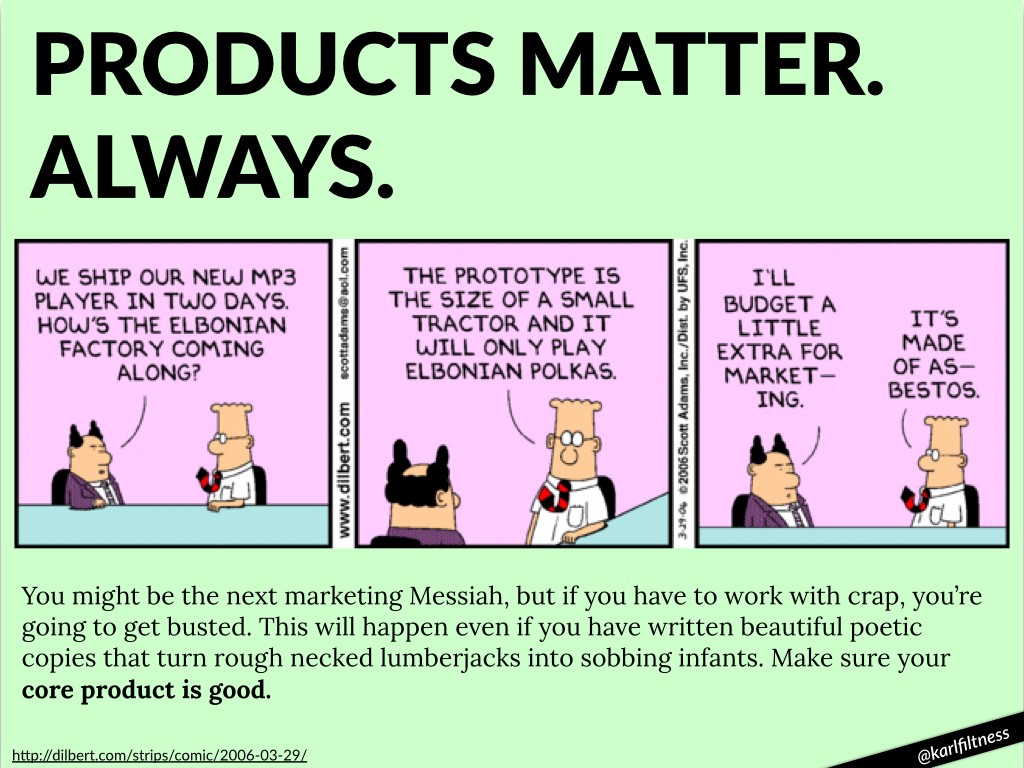
The second part of a changing perspective is knowing what makes enterprise customers tick. B2C selling is motivated by pure emotions. You offer stuff that saves time, money, efforts, and resources for consumers, while enterprise selling is all about doing more. It's easier to show how your SaaS will help a Fortune 500 company increase their ROI by 20% than convincing them it'll lower their opex by 10%.
You sell dreams to consumers and small companies, but you sell value to enterprises. That's the big difference.
Understand the anatomy of enterprise selling
Enterprise sales is a game played by multiple players. Some players help you hit the goal while others stop you from moving ahead. Some are simply there to evaluate the process. Knowing the players is crucial because there are only so many surprises you can handle in a meeting.
The Champions
If your SaaS has a unique enough proposition, some people will see its value right away. These people understand the pain you're trying to solve, perhaps see use cases beyond what you offer right now and rally behind you to close the deal.
In meetings try to find the champion(s).
If you spot them, learn more about their seniority. Talk to them. If they're in an authoritative position, it's gold — if not, try finding the senior fence-sitters who can be turned into champions of your product.
The champions are your saviors. Find them and hold on for your dear life.
The Challengers
For every champion in an enterprise, there's a challenger. The challengers make it difficult for you to take your pitch ahead and they have compelling arguments against your every move.
Even after a flawless pitch, you might be told that your product or service is not easy enough to learn and deploy, costs more than their budget, doesn't give strong enough ROI, or all of these together.
It's important to know where the challengers are coming from. In most cases they hate the change your SaaS will bring to the company. It might be possible that they are responsible for the existing system. Either way, recognize them and gather enough champions to offset the cynics.
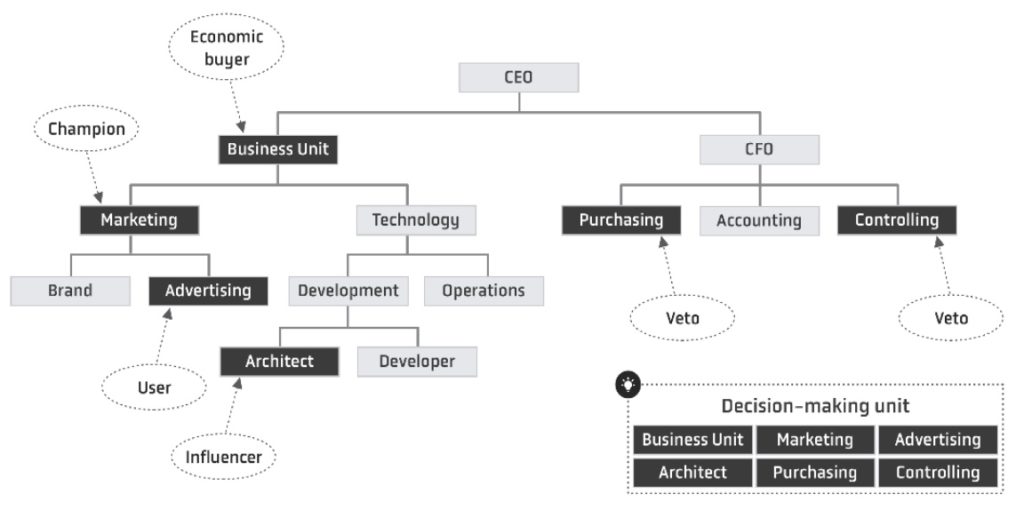
The Money Talkers
If you manage to go through the initial talks, you'll land in a room with the money talkers. The core deal is made here.
The money folks discuss the finances — the impact of your solution on the company, the dent it will create on the budget, and how the financial structure should look like for the partnership. They'll do their best to get the best deal possible so you're in for difficult conversations. Give them private beta access or a discount. Remember that an enterprise customer doesn't just give you money, but also clout and bragging rights.
Once they get something from your end, they'll move to the payment structure. Some teams prefer one-time payments upfront while others are more comfortable with the monthly payments for SaaS.
Understand how they want to move ahead and tweak your pricing strategy accordingly. Since you're still in the early days, each interaction with potential customers gives you data to refine your pricing and sales process.
The Users
When you first start creating your SaaS, you must have a vision and a hypothetical user base for it. The hypothesis meets reality at this juncture. Your SaaS gets unboxed and turned over its head at the hands of the end-users or technical experts. Identify the user base in the company and try talking to them personally.
If the enterprise customer is the end-user, then you'll meet potential users on the company premises. If it's a solution the enterprise is planning to deploy to their customers, you might have to go further to get hold of the customers. As an early-stage founder, there's nothing better than learning about customers while selling.
How to set up a proper sales strategy?
Now you know the players involved in making a deal at an enterprise. So how do you actually do sales?
I learned to develop a sales strategy that's universal across enterprise customers. You might have to tweak some aspects depending on the company you're pitching to, but there's a general thread that connects all enterprise sales.
Even before the challengers throw second opinions at you, anticipate the questions and solve them immediately. The two biggest questions are
- Why buy the solution?
- Why buy the solution from you?
Let's start with the first question — what motivates an enterprise customer to do something?
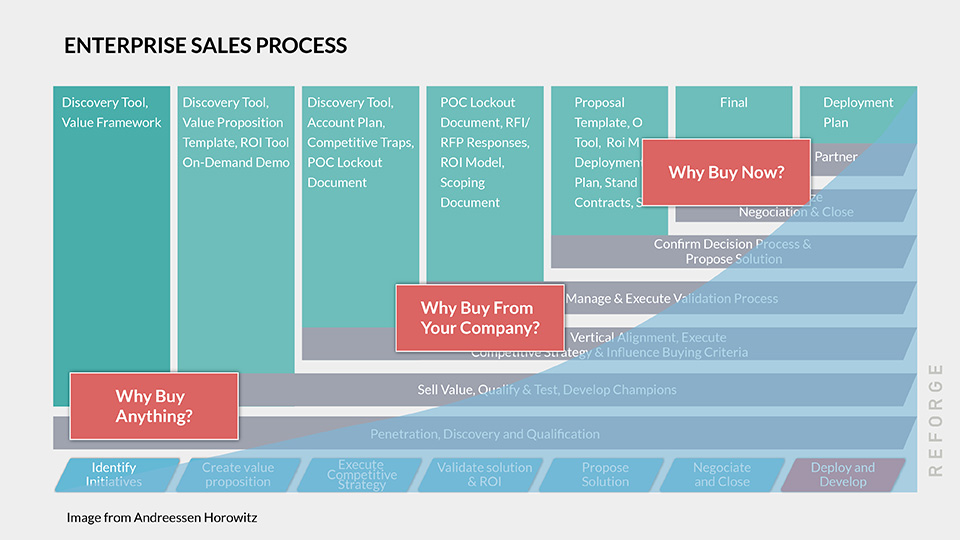
Enterprise Motivation
Usually, an enterprise has stuff figured out. It hates changes because the ripple effect can cost them a fortune. Plus the challengers really love the comfort of familiarity. But the enterprise also knows that they could always be doing something better. And this is where your SaaS comes in.
Detect the near-term goals of the enterprise and see the roadblocks. Now position your SaaS as the unique solution for this. While doing this, always remember to create ROI value. For example, if the company is planning to expand to a new market, show how your product can help them get there faster, make geo-compliance smoother, or access customers from deeper regions. The goals, the pain points, and compelling ROI models should help your prospect recognize that they need a solution.
But why should they buy from you? Large-scale companies check alternatives all the time to make sure they get the best deal. You helping them see issues first doesn't influence that decision. The best way to block competitors from creeping into the conversation is by painting success for people who call the shots.
Salespeople assume bigger responsibility here because the target has already shown interest and it's time to hit it home. Double down on your unique value proposition the way only you can about your SaaS and develop messaging for different groups of stakeholders. From C-level to managers and end-users — everyone should be convinced of your consultancy services. From selling to enabling success, change your position to compel enterprises to buy only from you.
Save your time (and theirs)
So you have positioned your SaaS and convinced the stakeholders that you're the only company that can help them. Sounds great! But there's a crucial step yet to be taken — selling the SaaS right now.
I cannot reiterate this enough — enterprises need to be nudged in the right direction till you sell it to them. But you've barely started so you don't have all day.
Since enterprise sales is a lengthy process, you can quickly find yourself attending long meetings that go nowhere. This is why you need to find customers who would pay you immediately to deploy your SaaS. Ask them if the problem is one of their top priorities right now. If they say no, note down the future timeline so that you can circle back later.
Selling to businesses that needed the solution yesterday is infinitely better than casual shoppers wandering in the SaaS market. To find customers like these, qualify prospects as if your life depends on it. Before doing a cold outreach, interact with founders and managers on LinkedIn to qualify them. If there's no fit, don't approach them in the initial days.
If you have found a few interesting prospects but are not sure they're ready to buy right now, put their intentions to test. Ask them to sign an NDA or charge a fee for a custom demo on their system to weed out the casuals. Anything that requires commitment should push the right ones deep into the funnel. This way you not only save your time but also theirs.
What are the best practices in selling to big enterprise companies?
Now that you know the various factors that impact enterprise sales, it's time to remember some dos and don'ts. I have been through this myself and I wish someone told me these tricks back then.
Don't focus on one decision-maker
This is an underexplored enterprise sales best practice that can take you closer to the deal. When founders with little sales experience find the champions, they get too enamored by them. But champions are only a part of a bigger puzzle — you have to touch bases with every player involved. While you're busy interacting with the people who "get it", your competitors are driving conversations with other stakeholders. At the end of the day, it's your job to convince everyone, so don't be scared to branch out and talk to more people in the company.
Close boldly
Hacker turned founders are too shy to go all the way in meetings. I have seen this happening and it pains me to see how much money was left on the table. When you know you have done everything right and you have got their nods, ask for the contract. Simple as that. Deliberation breeds second-guessing.
Be bold in the closing moments and leave the room with a contract.
Hire better
The enterprise sales cycle is designed to grind you down. As a new startup, you can neither back down nor hang in there forever. The best way to instantly improve your sales strategy is by hiring awesome SDRs and sales reps. To hire salespeople, look for the hacker mindset. Look for people who thrive in uncertainties, people who see unanticipated challenges and think "Okay, this doesn't look good. How can I solve this?" and people who are resilient and good at building relationships with other people.
Hiring experienced salespeople may be counterintuitive at this stage because they follow along the beaten path and cost you more money. In the first year, prioritize character and potential over resume experiences.
This point works if you want to hire a sales team to handle the client acquisition in the initial days. If you want to go solo, read on.
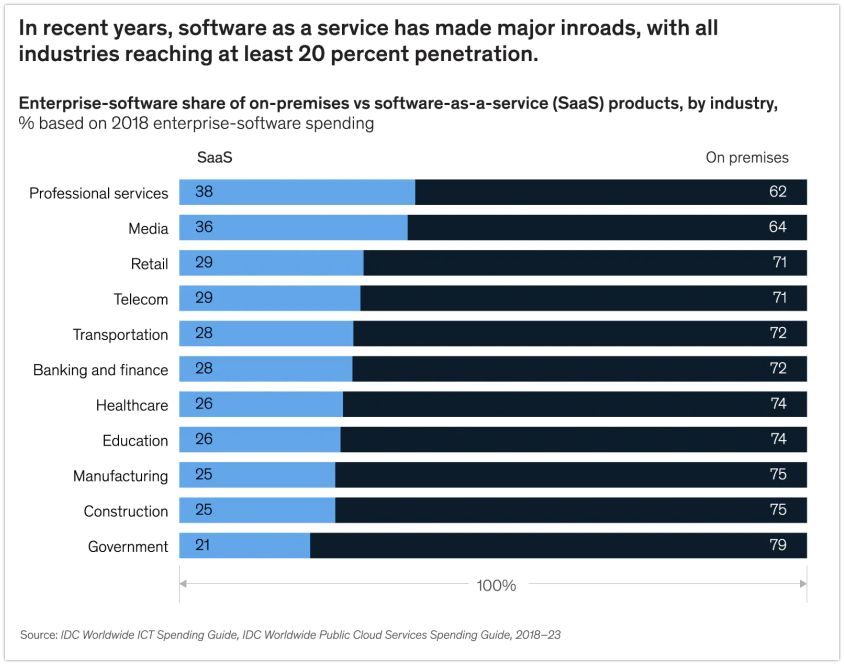
Doing sales as a technical co-founder
Technical co-founders have their work cut out in sales. But it's not impossible to survive the initial days and even land a few enterprise customers.
As the technical co-founder, you'll need to be able to talk about the product, and why it's different and better than the competition. You'll also need to know how to speak their language—so if they want a feature that will take six months and three developers with PhDs in astrophysics, you need to be able to tell them why that won't work without looking dumbfounded or startled.
Here's how you do it:
Learn what sales is not
Sales can be a lot of things but marketing is not one of them. Marketing takes you to the people, sales bring back paying customers. It's demand generation by casting a wide net vs lead generation by narrowing down on qualified prospects. Don't mix these two up and always try to align sales with marketing.
Share your story along the way
Even if you're not a developer, I'd argue that building in public is the best way to grow your business. By "building in public," I mean something along the lines of blogging and sharing your knowledge on social media and online platforms. Sharing your failures — people enjoy rooting for the underdog and this will get you your first customers also. I once built a small side-project for myself in public and gained 3 paying customers just by sharing my building steps on Twitter.
Building in public means, you're one of them, which allows you to create a niche following or community from the get-go.
Personal branding works like crazy — interact with people through your founder brand and this will help you close deals.
Cold outreach works
Perfectly executed cold outreach is not spam — it works great for early-stage startups. Cold outreach works, but it's not as effective as warm outreach. That's because cold emails are sent to strangers, while warm emails are sent to people who know you. It's the difference between Tinder and a personal connection. Cold emails are also riskier for startups because they often ask for favors from busy people. You can imagine that anyone important in the industry gets 10-20 such marketing emails per day.
The key is to avoid spamming and tailor your content to the person you are reaching out to. Don't ask too much in the email; offer something first.
As a technical co-founder, you also have the privilege that people don't usually expect marketing emails from CTO. So you have the benefit of the doubt when interacting with your clients, don't ruin that by becoming too pushy or too spammy. Also, Gmail might punish your emails if you send out generic ones.
Cold emails cost almost nothing, and they deliver solid ROI. Prioritize quality over quantity. And don't forget to have a follow-up plan. What's the goal, a call? A meet? Sending one email is rarely enough. You're trying to build a connection, not just notify the people of your existence.
Keep your product close, prospects closer
At the end of the day, sales is all about knowing — knowing your SaaS by heart, being acutely aware of the problem it solves in the market and knowing what are the benefits that the enterprise clients are getting.
As a technical co-founder, it's your job to show your clients that you have full confidence in your product to deliver on its promises. When a salesperson talks, they usually boast and overpromise and it rarely convinces people that the product can actually do what they say it can do. But when you speak, as a CTO, your voice carries weight when you say that it can solve their problem. You don't have to say a lot during the sales pitches, but you need to be 100% sure of what you're telling them.
So far I have discussed a lot about the enterprise machine, but remember that you're still selling to real people with real emotions. Build problem statements, validate pain points, establish new values and close with confidence.
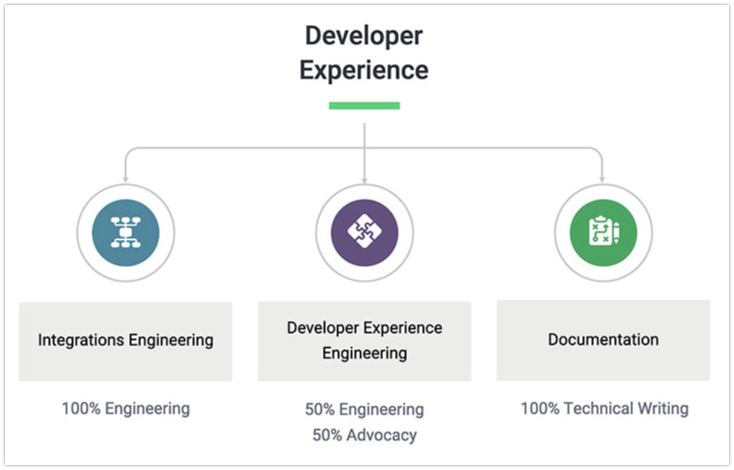
Improve your Developer Experience
What's the best way to get enterprise companies to use your product? Give their developers a great experience with integrating your solution. A nice Developer Experience (DX) can make or break a deal when clients evaluate all the different vendors available on the market.
Developers are always looking for better solutions, that check all the required boxes and if they don't have any good choices, they're going to stick with what they already have or go to the same vendor as always.
One good example of a proper Developer Experience is Stripe. What Stripe has done is taken the time to make sure that their product appeals to the developers first and then to everyone else. It offers amazing interactive documentation and integrates well with other products. They're constantly making sure that what they offer will be a seamless addition to an enterprise customer.
You as a technical co-founder need to make sure that your software can be easily integrated with other solutions — as more often than not, your SaaS will not be used standalone but require third-party integrations with multitudes of systems.
When you make developers advocates for your product, you don't have to spend a single dollar on marketing. The developers will be your marketers and evangelists inside big companies.
Be enterprise-ready
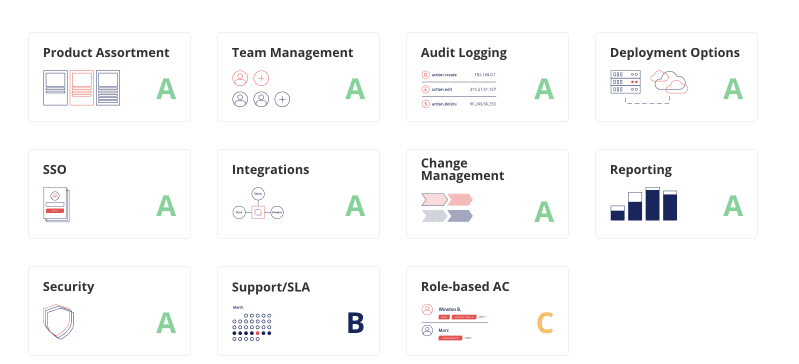
Think of being "enterprise-ready" as a list of checkboxes you need to fill in. At its core, it tells your buyer that your product can run under the extreme conditions that a big company will put it on.
These are the things you need to keep in mind when developing enterprise-level SaaS:
- Product Assortment — Big corporations will onboard thousands of users. Can your SaaS handle those or did you forget to add pagination to the user directory. You should offer variations of your product to capture value more proportionally, special discounts for enterprise, and multi-year lockins.
- Security — SSO integration is a must. There's no way around it, you will need to integrate the centralized user management with their KeyCloak or other Identity providers. Don't forget Role-Bases Access Controls, Resource Access Lists, Audit Logs.
- Change management & Support — there needs to be clear process definitions on how you deploy new features and how a big corporation can approach you to fix bugs or adapt software to fit them. Usually it involves a dedicated customer success manager on your side.
- And many more. I would recommend taking a look at EnterpriseReady to see what criteria you need to meet in order to be accepted as the vendor.
If you want to showcase all of those features I listed above, it's a good idea to get certifications. Compliance audits are the way to go to ensure your products and services deliver on the security they promise. You get a third-party company to vouch for your software by providing independent verification that the product or service meets all the requirements for security and privacy.
Closing thoughts
At the end of the day sales as a technical co-founder is the same as sales as the CEO — building connections with your clients and overdelivering on the promises that you make to them. And if you maintain this pace, it will be easier and easier to win clients overtime because you can confidently say "we did the same thing you want with company X, and they are satisfied with the results, actually we can arrange a meeting with them to discuss how they're using our software and you'll see it first hand"
When you're a young startup, just started, and have zero credibility — having the audacity is very important to close sales. Be bold and confident. But remember, you'll still have to deliver.
Thanks for reading! Here are some things I think you might like:
-
Leo
I’ve learned that keeping things simple often wins the game in enterprise sales. In my own journey, I noticed that when I presented my SaaS as a plug-and-play solution with flexible pricing, it caught more attention. Big companies are bombarded with complex pitches daily. A solution that promises ease of integration and minimal disruption stands out. It’s not always the most advanced tech that wins but how you package and position it for easy adoption.
-
Ethan M.
In the early stages of a SaaS startup, targeting enterprises, the key to success is building trust and connections before pitching your product. Each enterprise has unique challenges; tailoring your solution to address these directly can make a significant difference. Establishing genuine relationships and understanding specific needs are crucial in making your offering stand out.
-
Ollie
I found that directly engaging with early users to gather real-time feedback massively accelerated our product development. Starting with smaller enterprises also proved more fruitful, as they were quicker to adopt and offer practical insights.
